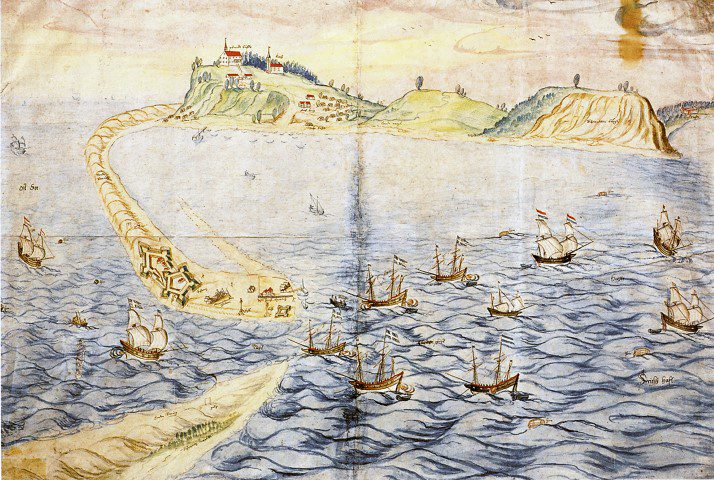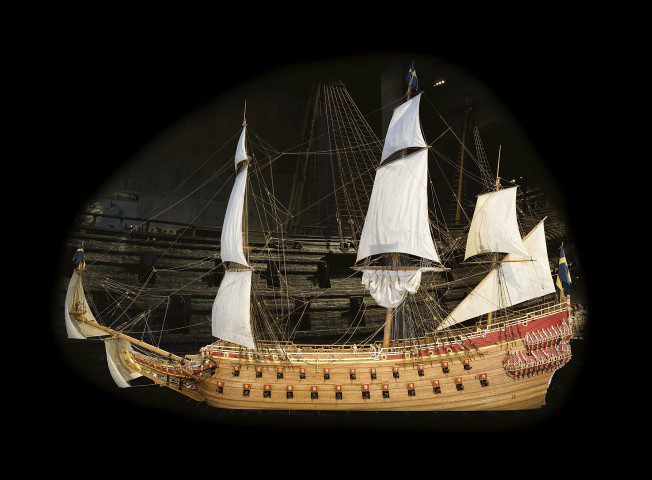Katarina Villner
Stockholm, Sweden

And of scurvy the teeth fall out of them;
for scurvy and throat diseases I have used lemons
as long I had any left, for as soon as I came down
I bought 200 lemons from a Dutch ship and he had no more.1
Henrik Fleming, a Swedish nobleman, wrote the above quotation in a report to Axel Oxenstierna, the Chancellor to the Swedish King Gustavus Adolphus at the end of July 1628. Sweden was a rising power in the Baltic in the 1620s, with Denmark as its main rival together with Russia and Poland. Gustavus Adolphus believed that he was defending peace and the Protestant faith. He attacked Poland 1626, and in 1630 Sweden entered the Thirty Years War in Germany on the Lutheran side. The King died at the Battle of Lützen in 1632, but he Swedish armies continued to be a successful force in Northern Europe until the end of the Thirty Years War in 1648.
On July 1, 1628 Henrik Fleming was appointed Vice Admiral of eight ships of the Swedish navy stationed at the south of the Baltic Sea, with orders to blockade the Polish ports, to put economic pressure on Poland, take toll of merchant ships and escort the Swedish war transports of men and necessities. He was an eye-witness to the life onboard wooden warships in the 1620s.
The life he describes would have been reality for the crew and soldiers of the now famous Swedish warship Vasa. This 64-gun ship capsized in Stockholm harbour as she set out on her maiden voyage on August 10, 1628. Vasa was one of the earliest warships built with two gundecks and especially cast lightweight bronze cannon (24-pounders). This development was an important step in naval warfare. Unfortunately, the problems of balancing strengh, firepowder and seaworthiness were complex and caused the sinking of the ship. The Vasa stayed underwater for 333 years and was raised in 1961. It is now shown, complete to 98% original in her own museum in Stockholm.

The Vasa had a crew of officers and seamen totaling 145 men. Her maiden voyage would have ended at a naval base in the Swedish archipelago to take onboard 300 soldiers. Eventually the large Vasa would have been ordered to the southern end of the Baltic near Poland. Swedish seamen and soldiers were recruited from coastal areas and employed for a single season. They were attracted by food, clothing, and regular but low wages, all of which were often insufficient on land. A strong naval fleet was considered necessary for the safety and success of the country. Every coastal town undertook from 1629 to supply the Crown with a certain number of seamen. In England pressing was often used to supply seamen, while in Amsterdam there was a well organized market for sailers. It was a tough croud sailing these ships, surviving the hard life onboard, storms and bad weather.
A first impression of a visit onboard such a ship for us today would be the foul smell of the men and their clothing, neither having been washed for a long time, and the smell of the bilge water. Lice, fleas, and vermin were daily companions. No formal uniforms were issued, only one set of woollen clothing (knee-length trousers and jacket), were worn by each sailor, not warm enough for the winter and too hot for the summer. Five bone or wooden combs found on the Vasa show that combing hair, beards, and shaving were means of keeping free from parasites. Tellingly, two cat skeletons and no rat skeletons were found while excavating the ship.
To prevent illnesses there were recurrent orders to clean the ships, which were smoked with juniper or tar. We do not know the daily routine, but usually decks on wooden ships are scrubbed every day to keep them clean and moist. One kind of punishment must have been to clean the beakhead where the only two heads were situated. The beakhead is the protruding bow of the ship. The deck of the beakhead was made like a grating. Because of this the heads were automaticly flushed while at sea, but in harbor …

When not on watch the crew on the Vasa, would have spent their free time and slept between the gun-carridges on the two gun decks. Officers and specialists shared the few small cabins in the stern. The orlop deck and the hold were used for storage. The dryer food and equipment were kept on the orlop deck and casks of salted food, water, beer, ammunition etc. were kept in the hold. The food was free but monotonous and poor in vitamins. It consisted of hard bread, weak beer, peas, dried or salted fish (mainly herring), and salted meat (beef, mutton and pork). Butter was found in two small containers on the Vasa. In the middle of the hold a brick lined galley without chimney was situated. The largest cauldron´s capacity was only 140 liters, large enough to feed only half or one third of the crew with warm pea soup or stews. The officers, seamen and soldiers had mostly the same menu, but the rations were larger for officers and specialists. The food was served on ceramics and pewter in the stern to the officers, while wooden platters were used by the seamen and sailors on the gun decks. There the men in groups of six or seven, shared the food between the gun carriages. Each man was provided a certain amount of bread, peas, meet or fish each day and 2.5 liters of beer:
We need all sorts of dry food and salt green meat with butter and fish, other than bread, flour and drink, which I have taken up from a Swedish ship, and divided between the (eight) ships. There is a need of gunpowder and I don´t have any ship to send for firewood…
The crew was divided into two watches, of which one was on duty for four hours at a time. Interrupted sleep was one of many inconvenieces onboard. But it could often also be the opposite; the boredom must have been madening while laying at anchor awaiting the right winds or during blockade service:
I think that they the whole summer from March have been still on the ships and never been ashore and have had passable of food and drink and have not done anything but slept day and night, and because of this first been contaminated and then more and more as they slept in between each other.
Characteristic of the ships at that time was the bad state of health of the men. The poor quality of food, the shortage of food, the often putrid water, the crowded decks, and the deficient hygiene were the reason. Amputations were not common, as seamen and soldiers died more from disease than from the injuries of sea battles. The health was especially bad onboard the ships in the southern Baltic. By March the season for Fleming´s ships had started. By the end of May 20% of 780 soldiers on eleven ships were ill or dead. In Fleming´s report we read that, at the end of July, 35% of the 433 soldiers on then only eight ships were ill, and the number increased daily. Among the illnesses he mentioned are malaria, ”leg diseases,” headache, scurvy, ”throat disease,” dysentery and other ”inflammatory diseases”:
For scurvy and throat disease I have used lemons as long as I had any. A few days ago a soldier had become the bloody flux on my ship and after 5 days I gave him something in with hot vine …
Fleming was distressed about his sick men. He immediately bought lemons as a remedy for scurvy and throat disease. This is interesting as scurvy was not mentioned in the indexes of the few contemporary Swedish medical books. Treating scurvy with something sour like citrus fruits or vinegar had long been known on the continent, even though it did not seem to be common knowledge among those familiar with medical care in Sweden. It was first in the middle of the 18th century that the Scot James Lind’s controlled experiments proved the effectiveness of citrus fruit as treatment:
If 5 get better 8 fall ill. Of my own servants 4 have been ill, one is better, 3 are weak of violent bonesickness, because I have always sent them to sick (on the other ships) with all sorts of drink and spices. And cooks and stewards who daily must spend time with them, are all ill.
Most medical and surgical care in the 17th century was the task of barber surgeons. It was not until 1650 that the Swedish navy got an Admiralty Physician. The gap was wide between barber surgeons and the few academically educated physicians who communicated in Latin and were mostly concerned with internal theraphy. The barbers, the predecessors of the surgeon, had sharp knives to cut hair, trim beards and shave. They did the ”simpler” and bloodier work, mixed herbal drugs, amputated arms and legs, lanced abscesses and treated burns and wounds. They also administrated bloodletting and cupping, another way of draining blood from the body:
My barber called Hans is since 12 days ill with strong bonesickness and must now lie there and die, what have been used for him did not help.
The small set of barber’s equipment found onboard the Vasa did not include surgical instruments. However, a whisk, wooden ladles, a very well preserved wooden mortar and pestel, a grater, a beer tap, a pewter flask, a pillbox and a stonewar jar could have been the equivalent to a contemporary emergency kit. Probably chests with more instruments, herbs, bandages etc. would have been taken onboard with the soldiers at the naval base. This medical equipment would have been what Fleming used to take care of his men. Thanks to Henrik Fleming we have a contemporary eye-witness account of life onboard a Swedish warship in the early 17th century. But his elaborate picture and his frank correspondance, was considered to be complaining by his superiors. Vice Admiral Henrik Fleming was not trusted with any further sea commissions.
Notes
- All quotes are from one document by Vice Admiral Henrik Fleming to Axel Oxenstierna, the Chancellor to the Swedish King Gustavus Adolphus dated 27 July, 1628. Original in Public Record Office, printed in Villner Katarina ”Blod, kryddor och sot” p 61-67.
References
- Hocker Fred. ”Vasa” A Swedish Warship, Stockholm, Sweden, Medströms förlag, USA, The David Brown Book Co, 2011.
- Vasa Museet. (n.d.). Retrieved from www.vasamuseet.se/en
- Villner Katarina. ”Blod, kryddor och sot” (with English summary), Stockholm, Sweden. Carlssons, 1986.
- Villner Katarina. ”Under däck”/ Under deck, Stockholm, Sweden, Medströms förlag, 2012. (Medical care and life conditions on the three warships, the English Mary Rose which capsized at Portmouth 1545 and the two Swedish, the Vasa which capsized in Stockholm 1628 and the Kronan which exploded outside the Swedish island of Öland 1676. Looking for economic means to translate and publish my book Under Deck.)
KATARINA VILLNER, retired director of information and marketing at the National Maritime Museums of Sweden, including the Vasa Museum. She has a degree in information, political science and ethnology from Stockholm University. Katarina Villner has also been researching medical health and living conditions on contemporary warships in England and Sweden. She has published two books on the subject. (The Vasa Museum is by far the most visited museum in Scandinavia, usually 1,2 million visitors/year.)
Highlighted in Frontispiece Volume 6, Issue 3 – Summer 2014

Leave a Reply